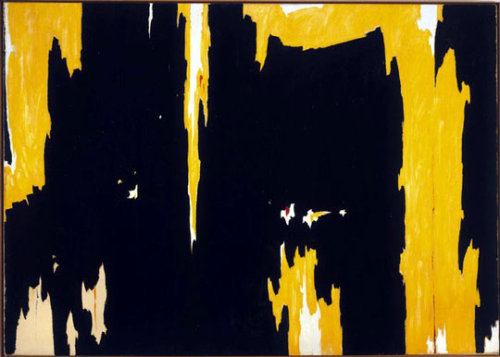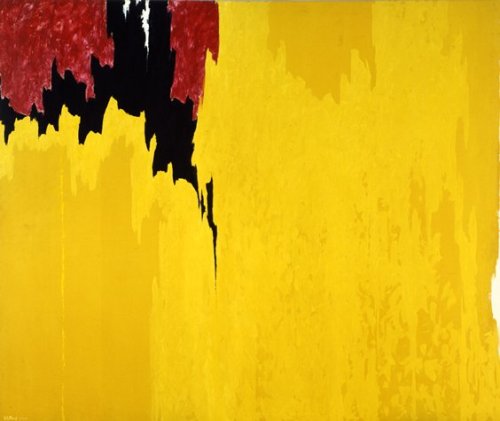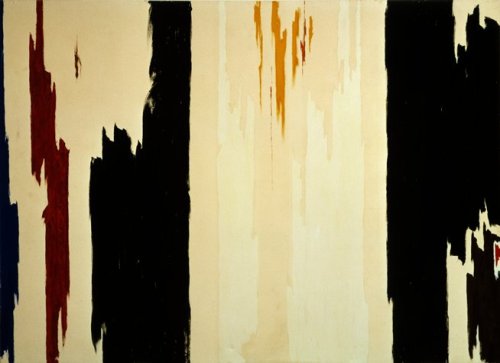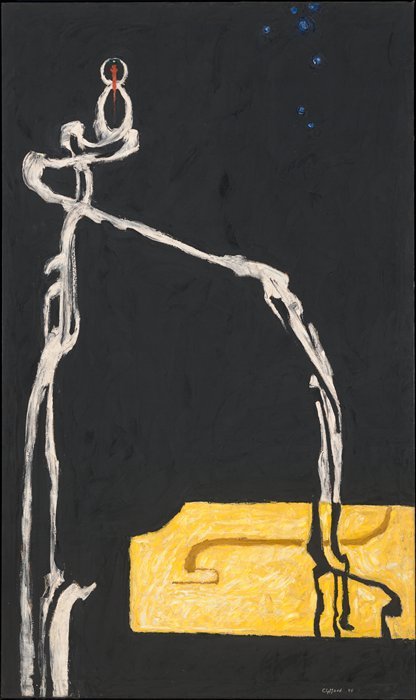#clyffordstill
PH-343, 1937,Clyfford Still
Medium: oil
https://www.wikiart.org/en/clyfford-still/ph-343-1937
Post link
Untitled, 1957,Clyfford Still
Medium: oil
https://www.wikiart.org/en/clyfford-still/untitled-1957
Post link
Figure, Clyfford Still, 1944,MoMA: Drawings and Prints
Gift of Dorothy C. Miller
Size: composition (irreg.): 13 1/8 x 8 5/8" (33.3 x 21.9 cm); sheet: 20 x 13" (50.8 x 33 cm)
Medium: Lithograph, with black crayon additions
http://www.moma.org/collection/works/74531
Post link
1951-T No. 3, Clyfford Still, 1951,MoMA: Painting and Sculpture
Blanchette Hooker Rockefeller Fund
Size: 7’ 10" x 6’ 10" (238.8 x 208.3 cm)
Medium: Oil on canvas
http://www.moma.org/collection/works/79371
Post link
1951-52, Clyfford Still, 1951,Art Institute of Chicago: Contemporary Art
In the late 1940s, Clyfford Still, along with Barnett Newman and Mark Rothko, originated the type of Abstract Expressionism known as Field Painting, a term used to describe large canvases dominated by one uniform color or a few colors closely related in hue and value. In contrast to Newman and Rothko, who usually applied paint thinly and uniformly, Still used a palette knife, creating textural effects that give the surface a complex, nearly sculptural sense of materiality. Named after the years of its creation, 1951–52 is a rare, nearly all-black work in the artist’s oeuvre. A vertical white line to the right of center and a thin streak of red-orange along the left side provide the sole interruptions in the black field. The subtle modulations of texture and finish support the artist’s claim that “I do not oversimplify—in fact, I revel in the extra complex.” Wirt D. Walker Fund; gift of John Stephan
Size: 301.8 x 396.2 cm (118 ¾ x 156 in.)
Medium: Oil on canvas
https://www.artic.edu/artworks/15569/
Post link
1953, Clyfford Still, 1953,Tate
date inscribed Purchased 1971
Size: support: 2359 x 1740 mm
Medium: Oil paint on canvas
http://www.tate.org.uk/art/artworks/still-1953-t01498
Post link
Untitled, Clyfford Still, 1958,Art Institute of Chicago: Contemporary Art
In the late 1940s Clyfford Still, along with Barnett Newman and Mark Rothko, originated the type of Abstract Expressionism known as color-field painting, a term used to describe very large canvases dominated by monumental expanses of intense, homogeneous color. Like most of Still’s mature work, Untitled is a sheer wall of paint, imposing and self-sustaining, that makes no concessions to conventional notions of beauty or pictorial illusionism. This painting’s textural effects give it an insistent, complex materiality. Dominated by blacks applied with both a trowel and brushes, the surface is by turns reflective and chalky, granular and smooth, feathery and leaden. These variegated black surfaces are even more emphatic because their continuity is broken by areas of blank canvas and white paint. Like veins in igneous rock, streaks of orange, yellow, and green paint are embedded in the black voids. Mediating between the light and dark masses are areas of crimson, heightened at the edges, as if inflamed, by bright orange. Mr. and Mrs. Frank G. Logan Purchase Prize Fund; Roy J. and Frances R. Friedman Endowment; through prior gift of Mrs. Henry C. Woods; gift of Lannan Foundation
Size: 290.2 × 406.4 cm (114 ¼ × 160 in.)
Medium: Oil on canvas
https://www.artic.edu/artworks/146991/
Post link
Untitled (formerly Self-Portrait), 1945,Clyfford Still
Medium: oil
https://www.wikiart.org/en/clyfford-still/untitled-formerly-self-portrait-1945
Post link
1951-52, Clyfford Still, 1951,Art Institute of Chicago: Contemporary Art
In the late 1940s, Clyfford Still, along with Barnett Newman and Mark Rothko, originated the type of Abstract Expressionism known as Field Painting, a term used to describe large canvases dominated by one uniform color or a few colors closely related in hue and value. In contrast to Newman and Rothko, who usually applied paint thinly and uniformly, Still used a palette knife, creating textural effects that give the surface a complex, nearly sculptural sense of materiality. Named after the years of its creation, 1951–52 is a rare, nearly all-black work in the artist’s oeuvre. A vertical white line to the right of center and a thin streak of red-orange along the left side provide the sole interruptions in the black field. The subtle modulations of texture and finish support the artist’s claim that “I do not oversimplify—in fact, I revel in the extra complex.” Wirt D. Walker Fund; gift of John Stephan
Size: 301.8 x 396.2 cm (118 ¾ x 156 in.)
Medium: Oil on canvas
Post link
Untitled, Clyfford Still, 1958,Art Institute of Chicago: Contemporary Art
In the late 1940s Clyfford Still, along with Barnett Newman and Mark Rothko, originated the type of Abstract Expressionism known as color-field painting, a term used to describe very large canvases dominated by monumental expanses of intense, homogeneous color. Like most of Still’s mature work, Untitled is a sheer wall of paint, imposing and self-sustaining, that makes no concessions to conventional notions of beauty or pictorial illusionism. This painting’s textural effects give it an insistent, complex materiality. Dominated by blacks applied with both a trowel and brushes, the surface is by turns reflective and chalky, granular and smooth, feathery and leaden. These variegated black surfaces are even more emphatic because their continuity is broken by areas of blank canvas and white paint. Like veins in igneous rock, streaks of orange, yellow, and green paint are embedded in the black voids. Mediating between the light and dark masses are areas of crimson, heightened at the edges, as if inflamed, by bright orange. Mr. and Mrs. Frank G. Logan Purchase Prize Fund; Roy J. and Frances R. Friedman Endowment; through prior gift of Mrs. Henry C. Woods; gift of Lannan Foundation
Size: 290.2 × 406.4 cm (114 ¼ × 160 in.)
Medium: Oil on canvas
Post link




















